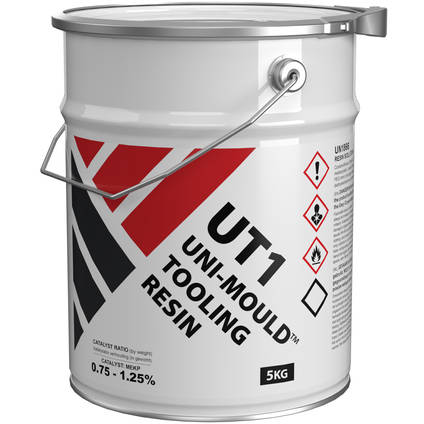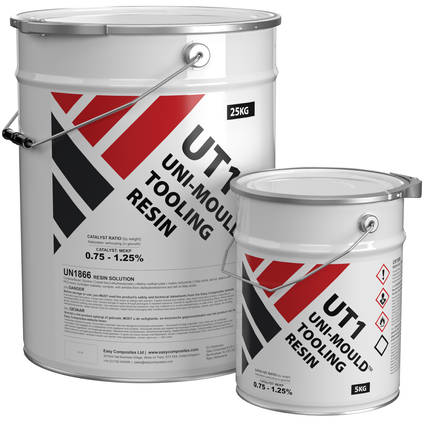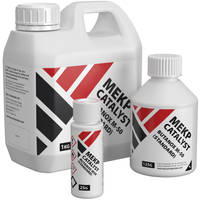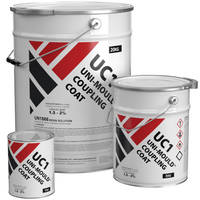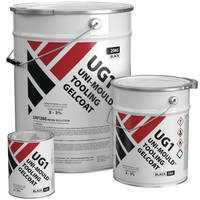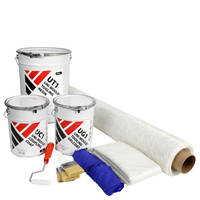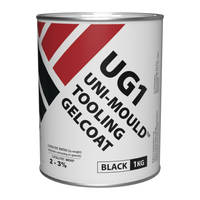Heb je hulp of advies nodig?+44 (0)1782 454499
Downloads (3)
Dit is een chemisch product. Voor opslag of gebruik moet u de bijgevoegde veiligheids- en technische informatiebladen downloaden en lezen.
| Veiligheidsinformatieblad (SDS) - NL | ||
| Veiligheidsinformatieblad (SDS) - NL | ||
| Technisch gegevensblad (TDS) |
Specificatie
Productgegevens
| Kleur | Beige | |
|---|---|---|
| Chemie / Materiaal | Polyester | |
| Viscositeit | 1600 | mPa.s |
| Flexibiliteit | Hard/stijf |
Geharde Echanische Eigenschappen
| Max. Onderhoudstemperatuur | 90 | °C |
|---|---|---|
| Hardheid | 70 (Hard) | Kust D |
| Treksterkte | 100 | MPa |
| Buigsterkte | 141.3 | MPa |
| Rek bij Breuk | 7.08 | % |
Levensduur Pot en Uithardingstijden
| Levensduur Pot (Normaal) | 35 | minuten |
|---|---|---|
| Initiële Uithardingstijd | 24 | Uur |
| Volledige Uithardingstijd | 7 | Dagen |
Algemene Eigenschappen
| Brutogewicht | 5.25 | kg |
|---|
Verzendinformatie
Beperkingen
Dit product is geclassificeerd als gevaarlijke goederen voor transport.
Het kan worden verzonden naar alle landen op het vasteland van de EU, Ierland, de Balearen, Corsica, Sicilië en Sardinië.
Helaas kunnen we op dit moment geen gevaarlijke goederen verzenden naar Cyprus, Malta, de Canarische Eilanden, Ceuta, Melilla, Jan Mayan en Spitsbergen.
Zie onze pagina met leveringsinformatie voor volledige informatie over de verzending van gevaarlijke goederen.
Verpakkingsgrootte
Er zijn geen beperkingen op de pakketgrootte of toeslagen voor dit product.
Verzendkosten
Om de bezorgkosten van dit artikel naar uw adres te achterhalen, voegt u het toe aan uw winkelwagen en gebruikt u vervolgens de directe verzendkosten calculator op de winkelwagenpagina.
UT1 Uni-Mould Tooling Hars
- UT1-5
Gevaarlijk
- Geen Beoordelingen
UT1 Uni-Mould Tooling Resin is een met lage krimp gevuld polyester laminaat voor composiet mallen en gereedschappen. De speciale gevulde samenstelling is ontworpen voor gebruik in een rapid tooling systeem waarbij alle matrijsversterking tegelijkertijd wordt gelamineerd, waardoor de matrijs aanzienlijk sneller kan worden geproduceerd in vergelijking met een conventionele lamineerhars.
Deze speciale gevulde tooling hars moet worden gebruikt als onderdeel van het Uni-Mould rapid tooling systeem.
Vereist MEKP katalysator, niet inbegrepen. Online te koop in blikken van 5 kg.
PRODUCTVERSIES
Verpakkingsgrootte
BESCHIKBAARHEID:Niet op voorraad
Nieuwe voorraad is onderweg. Als u dit product bestelt, wordt uw volledige bestelling vastgehouden en naar u verzonden zodra dit product weer op voorraad is.
Optionele items
PRODUCTOPTIESNieuwe voorraad is onderweg. Als u dit product bestelt, wordt uw volledige bestelling vastgehouden en naar u verzonden zodra dit product weer op voorraad is.
Handelskortingen
| 0-4 | 5+ |
|---|---|
| €44.00 | €39.14 |
We zijn niet te verslaan op prijs!
Als u denkt dat u elders een gelijkwaardig product goedkoper kunt kopen, neem dan contact met ons op om uw wensen te bespreken.
UT1 Uni-Mould Tooling Resin maakt deel uit van het Uni-Mould™ universele matrijsmaaksysteem en moet worden gebruikt in combinatie met Uni-Mould Tooling Gel Coat en Uni-Mould Coupling Coat om slijtvaste, polijstbare matrijzen van elk formaat te maken zonder krimp, geschikt voor gebruik in vrijwel elk composietproces.
Lees voor meer informatie over het Uni-Mould systeem onze Introductie- en toepassingsgids voorUni-Mould .
MEKP-katalysator vereist (niet inbegrepen)
Voorgestelde aankoophoeveelheden
Gebruik de onderstaande tabel om geschikte hoeveelheden hars en glas te kopen voor een bepaalde malgrootte.
| UT1 Uni-Mould hars | Gehakte mat | ||||
|---|---|---|---|---|---|
| De tabel is GEEN exacte richtlijn voor de verhoudingen van de materialen, maar is naar boven afgerond op de dichtstbijzijnde pakmaat of gewicht van de mat. | |||||
| Vorm Gebied | Gereedschapsgel | Koppelingsmantel | Tooling Hars | 100g | 450g |
| 0.6m² | 1kg | 1kg | 5kg | 2m² | 2kg |
| 3.5m² | 5kg | 5kg | 25kg | 7m² | 7kg |
| 13m² | 10kg | 25kg | 100kg | 26m² | 25kg |
Verdere informatie
Toepassing
De lamineertechniek voor UT1 Uni-Mould Tooling Resin is heel anders dan die van conventionele polyester tooling resins of lamineerharsen en het is essentieel dat je jezelf vertrouwd maakt met deze techniek en de richtlijnen zorgvuldig volgt om de hars goed te laten uitharden en een succesvolle mal te krijgen.
UT1 Uni-Mould Tooling Resin hardt uit door zijn eigen exotherm en moet tijdens het uitharden een temperatuur van 50-60°C bereiken om zijn volledige eigenschappen te bereiken. Om dit te bereiken moet de omgeving van je werkplaats tussen 18°C en 25°C zijn en moet je in één keer minimaal 4 lagen 450gsm of harsrijke (4:1) CSM op de achterkant van de mal leggen.
Voorbereiding
Om ervoor te zorgen dat alle wapening in één sessie gelegd kan worden, is het belangrijk om de hars en wapening van tevoren voor te bereiden voordat je begint met lamineren.
Snijd je 450gsm CSM in de juiste vorm voor je mal, met minimaal 4 lagen mat. Zodra je de mat hebt gesneden, weeg je deze om te zien hoeveel CSM je gaat gebruiken.
Weeg vervolgens 4 keer het gewicht van het glas af in hars (UT1 Uni-Mould Tooling Resin moet worden gebruikt met een typische 4:1 verhouding of hars tot glas), wat betekent dat als je 5 kg CSM gebruikt om je mal te versterken, je 20 kg hars moet voorbereiden.
Begin met lamineren
Als je klaar bent, katalyseer je de hars met MEKP katalysator (niet meegeleverd) aan 0,75 - 1,25% (afhankelijk van de omgevingstemperatuur) en meng je grondig.
Breng snel hars aan over de hele mal en voeg dan één voor één lagen glas toe, nat makend met veel hars (4:1 in gewicht) totdat je alle lagen glas aan de achterkant van de mal hebt toegevoegd. Je moet de laatste van de voorbereide hars gebruiken als je de laatste laag CSM toevoegt.
Als het laminaat begint uit te harden, stijgt de temperatuur tot 50-60°C en verandert de kleur van het laminaat van middenbruin naar lichtbruin.
Laat de hars 24 uur volledig uitharden.
Gebruik met Prepregs
Hoewel het mogelijk is om Uni-Mould mallen te gebruiken met prepregs die buiten de autoclaaf (ovenhardend) zijn gemaakt (zoals XPREG® XC110), raden we Uni-Mould mallen niet langer aan voor dit doel.
In plaats daarvan - voor prepreg gebruik - worden betere resultaten bereikt met hoge temperatuur epoxy matrijzen gemaakt met behulp van ons EG160 / EMP160 gereedschapssysteem of XPREG® XT135 Tooling Prepreg. Met deze hoge temperatuur epoxy gereedschapssystemen kan de prepreg worden uitgehard op de optimale temperatuur van 120°C. Dit verkort de uithardingstijd en verbetert de mechanische eigenschappen van het onderdeel. Bovendien blijkt epoxygereedschap te resulteren in een betere oppervlakteafwerking met prepregs zoals XPREG® XC110.
Compatibiliteitsinformatie - Wat Wel en Niet Moet Doen
Hoewel dit zeker geen uitputtende lijst is, zijn de onderstaande matrijsmaterialen, pigmenten en additieven allemaal getest en staan ze bekend om hun goede werking met UT1.
Compatibele patronen
- Uni-Mould systeem
- UC1 Uni-Mould Koppelingsmantel
- Polypropyleen en polyethyleen plaat
- De meeste houtsoorten (bijv. verstijvingslatten in vormlaminaat/rand)
Compatibele losmiddelen
- Middelen voor chemische vrijgave (zoals Easy-Lease)
- Schimmelwerende was (zoals Miracle Gloss #8 Wax)
Compatibele additieven
- Vullen is niet nodig.
Belangrijke Verwerkingsinformatie
- Gebruiksgemak: Geschikt voor professioneel en hobbygebruik (volg het veiligheidsinformatieblad).
- Geur: Tooling Resin heeft een sterke geur op basis van styreen.
- Veiligheidsmaatregelen: Draag handschoenen en een veiligheidsbril en werk in een goed geventileerde ruimte. Lees voor gebruik altijd het veiligheidsinformatieblad (MSDS).
- Omgevingsomstandigheden: Kan gebruikt worden van 15 tot 30°C, hoewel de pot-life en uithardingstijd aanzienlijk beïnvloed worden. Aanbevolen bij een omgevingstemperatuur van 20-25°C.
- Ontgassen: Niet nodig. Gewoon mengen en gebruiken.
- Mengverhouding: Voeg MEKP Catalyst toe in een verhouding van 0,75 - 1,25%, afhankelijk van de omgevingstemperatuur. Gebruik een digitale weegschaal.
- Mengen: Meng grondig met de hand gedurende ongeveer 2 minuten.
- Toepassing: Kan worden aangebracht met kwast en kunststof vinnenroller
- Potlife: >De potlife bij 20°C is 35 minuten. Gebruik je hars voor deze tijd.
- Exotherm (oververhitting): Hars wordt warm terwijl het uithardt. Meng in kleine batches en gebruik snel. Gemengde hars in een pot raakt snel oververhit (exotherm) en kan gaan roken/ontbranden. Laat gemengde hars nooit onbeheerd achter.
- Maximale gebruikstemperatuur: Wanneer de Uni-Mould mallen volledig zijn uitgehard, is de maximale gebruikstemperatuur 90°C.
- Uithardingstijd/ontmaltijd: Bij 20°C is de ontvormtijd 24 uur.
- Overcoaten: Als dikkere mallen gewenst zijn, kun je de giethars 1 uur en 30 minuten nadat de eerste lagen "wit" en geëxothermeerd zijn overcoaten.
- Houdbaarheid: Uni-Mould tooling hars is 4 maanden houdbaar.
Handelskortingen
| 0-4 | 5+ |
|---|---|
| €44.00 | €39.14 |
We zijn niet te verslaan op prijs!
Als u denkt dat u elders een gelijkwaardig product goedkoper kunt kopen, neem dan contact met ons op om uw wensen te bespreken.
UT1 Uni-Mould Tooling Resin maakt deel uit van het Uni-Mould™ universele matrijsmaaksysteem en moet worden gebruikt in combinatie met Uni-Mould Tooling Gel Coat en Uni-Mould Coupling Coat om slijtvaste, polijstbare matrijzen van elk formaat te maken zonder krimp, geschikt voor gebruik in vrijwel elk composietproces.
Lees voor meer informatie over het Uni-Mould systeem onze Introductie- en toepassingsgids voorUni-Mould .
MEKP-katalysator vereist (niet inbegrepen)
Voorgestelde aankoophoeveelheden
Gebruik de onderstaande tabel om geschikte hoeveelheden hars en glas te kopen voor een bepaalde malgrootte.
| UT1 Uni-Mould hars | Gehakte mat | ||||
|---|---|---|---|---|---|
| De tabel is GEEN exacte richtlijn voor de verhoudingen van de materialen, maar is naar boven afgerond op de dichtstbijzijnde pakmaat of gewicht van de mat. | |||||
| Vorm Gebied | Gereedschapsgel | Koppelingsmantel | Tooling Hars | 100g | 450g |
| 0.6m² | 1kg | 1kg | 5kg | 2m² | 2kg |
| 3.5m² | 5kg | 5kg | 25kg | 7m² | 7kg |
| 13m² | 10kg | 25kg | 100kg | 26m² | 25kg |
Verdere informatie
Toepassing
De lamineertechniek voor UT1 Uni-Mould Tooling Resin is heel anders dan die van conventionele polyester tooling resins of lamineerharsen en het is essentieel dat je jezelf vertrouwd maakt met deze techniek en de richtlijnen zorgvuldig volgt om de hars goed te laten uitharden en een succesvolle mal te krijgen.
UT1 Uni-Mould Tooling Resin hardt uit door zijn eigen exotherm en moet tijdens het uitharden een temperatuur van 50-60°C bereiken om zijn volledige eigenschappen te bereiken. Om dit te bereiken moet de omgeving van je werkplaats tussen 18°C en 25°C zijn en moet je in één keer minimaal 4 lagen 450gsm of harsrijke (4:1) CSM op de achterkant van de mal leggen.
Voorbereiding
Om ervoor te zorgen dat alle wapening in één sessie gelegd kan worden, is het belangrijk om de hars en wapening van tevoren voor te bereiden voordat je begint met lamineren.
Snijd je 450gsm CSM in de juiste vorm voor je mal, met minimaal 4 lagen mat. Zodra je de mat hebt gesneden, weeg je deze om te zien hoeveel CSM je gaat gebruiken.
Weeg vervolgens 4 keer het gewicht van het glas af in hars (UT1 Uni-Mould Tooling Resin moet worden gebruikt met een typische 4:1 verhouding of hars tot glas), wat betekent dat als je 5 kg CSM gebruikt om je mal te versterken, je 20 kg hars moet voorbereiden.
Begin met lamineren
Als je klaar bent, katalyseer je de hars met MEKP katalysator (niet meegeleverd) aan 0,75 - 1,25% (afhankelijk van de omgevingstemperatuur) en meng je grondig.
Breng snel hars aan over de hele mal en voeg dan één voor één lagen glas toe, nat makend met veel hars (4:1 in gewicht) totdat je alle lagen glas aan de achterkant van de mal hebt toegevoegd. Je moet de laatste van de voorbereide hars gebruiken als je de laatste laag CSM toevoegt.
Als het laminaat begint uit te harden, stijgt de temperatuur tot 50-60°C en verandert de kleur van het laminaat van middenbruin naar lichtbruin.
Laat de hars 24 uur volledig uitharden.
Gebruik met Prepregs
Hoewel het mogelijk is om Uni-Mould mallen te gebruiken met prepregs die buiten de autoclaaf (ovenhardend) zijn gemaakt (zoals XPREG® XC110), raden we Uni-Mould mallen niet langer aan voor dit doel.
In plaats daarvan - voor prepreg gebruik - worden betere resultaten bereikt met hoge temperatuur epoxy matrijzen gemaakt met behulp van ons EG160 / EMP160 gereedschapssysteem of XPREG® XT135 Tooling Prepreg. Met deze hoge temperatuur epoxy gereedschapssystemen kan de prepreg worden uitgehard op de optimale temperatuur van 120°C. Dit verkort de uithardingstijd en verbetert de mechanische eigenschappen van het onderdeel. Bovendien blijkt epoxygereedschap te resulteren in een betere oppervlakteafwerking met prepregs zoals XPREG® XC110.
Compatibiliteitsinformatie - Wat Wel en Niet Moet Doen
Hoewel dit zeker geen uitputtende lijst is, zijn de onderstaande matrijsmaterialen, pigmenten en additieven allemaal getest en staan ze bekend om hun goede werking met UT1.
Compatibele patronen
- Uni-Mould systeem
- UC1 Uni-Mould Koppelingsmantel
- Polypropyleen en polyethyleen plaat
- De meeste houtsoorten (bijv. verstijvingslatten in vormlaminaat/rand)
Compatibele losmiddelen
- Middelen voor chemische vrijgave (zoals Easy-Lease)
- Schimmelwerende was (zoals Miracle Gloss #8 Wax)
Compatibele additieven
- Vullen is niet nodig.
Belangrijke Verwerkingsinformatie
- Gebruiksgemak: Geschikt voor professioneel en hobbygebruik (volg het veiligheidsinformatieblad).
- Geur: Tooling Resin heeft een sterke geur op basis van styreen.
- Veiligheidsmaatregelen: Draag handschoenen en een veiligheidsbril en werk in een goed geventileerde ruimte. Lees voor gebruik altijd het veiligheidsinformatieblad (MSDS).
- Omgevingsomstandigheden: Kan gebruikt worden van 15 tot 30°C, hoewel de pot-life en uithardingstijd aanzienlijk beïnvloed worden. Aanbevolen bij een omgevingstemperatuur van 20-25°C.
- Ontgassen: Niet nodig. Gewoon mengen en gebruiken.
- Mengverhouding: Voeg MEKP Catalyst toe in een verhouding van 0,75 - 1,25%, afhankelijk van de omgevingstemperatuur. Gebruik een digitale weegschaal.
- Mengen: Meng grondig met de hand gedurende ongeveer 2 minuten.
- Toepassing: Kan worden aangebracht met kwast en kunststof vinnenroller
- Potlife: >De potlife bij 20°C is 35 minuten. Gebruik je hars voor deze tijd.
- Exotherm (oververhitting): Hars wordt warm terwijl het uithardt. Meng in kleine batches en gebruik snel. Gemengde hars in een pot raakt snel oververhit (exotherm) en kan gaan roken/ontbranden. Laat gemengde hars nooit onbeheerd achter.
- Maximale gebruikstemperatuur: Wanneer de Uni-Mould mallen volledig zijn uitgehard, is de maximale gebruikstemperatuur 90°C.
- Uithardingstijd/ontmaltijd: Bij 20°C is de ontvormtijd 24 uur.
- Overcoaten: Als dikkere mallen gewenst zijn, kun je de giethars 1 uur en 30 minuten nadat de eerste lagen "wit" en geëxothermeerd zijn overcoaten.
- Houdbaarheid: Uni-Mould tooling hars is 4 maanden houdbaar.
Specificatie
Productgegevens
| Kleur | Beige | |
|---|---|---|
| Chemie / Materiaal | Polyester | |
| Viscositeit | 1600 | mPa.s |
| Flexibiliteit | Hard/stijf |
Geharde Echanische Eigenschappen
| Max. Onderhoudstemperatuur | 90 | °C |
|---|---|---|
| Hardheid | 70 (Hard) | Kust D |
| Treksterkte | 100 | MPa |
| Buigsterkte | 141.3 | MPa |
| Rek bij Breuk | 7.08 | % |
Levensduur Pot en Uithardingstijden
| Levensduur Pot (Normaal) | 35 | minuten |
|---|---|---|
| Initiële Uithardingstijd | 24 | Uur |
| Volledige Uithardingstijd | 7 | Dagen |
Algemene Eigenschappen
| Brutogewicht | 5.25 | kg |
|---|
De reden dat we MEKP niet buiten het Verenigd Koninkrijk kunnen vervoeren is omdat het sterk oxideert en standaard transportdiensten het niet toestaan.
Je kunt MEKP echter kopen bij alle leveranciers van composietmaterialen, inclusief glasvezelzaken, dakbedekkingsleveranciers, botenbouwers, autoschadeherstellers enz. Er is niets speciaals aan de MEKP die wij leveren, je kunt bij je plaatselijke leverancier vragen naar 'Standaard reactiviteit MEKP'; merken zoals Andanox KP9, Akperox A30, Butanox M50 (Akzo Nobel) zijn allemaal geschikt en overal verkrijgbaar.
Het is altijd de moeite waard om eerst een kleine hoeveelheid op een onopvallende plek te testen om te controleren of de gelcoat het vinyl niet aantast. Als je nog vinyl over hebt, kun je het door jou gekozen lossingsmiddel aanbrengen en een test doen met wat gel om er zeker van te zijn dat het goed loslaat. Afgezien daarvan zou het prima moeten zijn, vinyl over een onderdeel aanbrengen is een veelgebruikte techniek als de afwerking van het onderdeel mogelijk niet compatibel is met de gekozen tooling gel en het origineel beschermd moet worden.
Er is echt heel weinig waar je rekening mee moet houden als je Uni-Mould mallen op de lange termijn wilt bewaren. We hebben schimmels gehad die we jarenlang hebben gebruikt, soms elke dag, soms om de paar maanden. De enige omstandigheid die ze zou kunnen beschadigen, is als ze erg vochtig worden opgeslagen of worden blootgesteld aan het weer en de elementen. Omdat je een blootliggende glasvezelrand hebt, kan er na verloop van tijd water 'binnendringen' in de glasvezel en kunnen de schimmels verslechteren; dit zou echter lang duren en vereist constante blootstelling aan nat weer.
Het is ook de moeite waard om te vermelden dat als je een semi-permanent lossingsmiddel gebruikt, zoals Easy Lease, je je mallen een nieuwe laag lossingsmiddel moet geven als je ze opnieuw gebruikt als ze langer dan een paar weken opgeslagen zijn geweest.
Ja, je hebt MEKP Catalyst nodig voor het uitharden van al onze Uni-Mould harsen, inclusief de Tooling Gelcoat. Je kunt MEKP bestellen op de productpagina en je kunt MEKP ook hier vinden: MEKP Katalysator
Als je meer dan 4 lagen tegelijk aanbrengt, riskeer je oververhitting van de mal. Als je dikker wilt, moet je wachten tot de eerste 4 lagen zijn uitgehard, dan het oppervlak bewerken en nog eens 4 lagen aanbrengen (je hebt de dikte van 4 lagen nodig voor de warmte om de hars uit te harden).
Uni-Mould Tooling Resin, en de meeste harsen, zijn zeer temperatuurgevoelig en moeten worden uitgehard bij ongeveer 20°C waar mogelijk. Hoe lager de temperatuur, hoe langer de uitharding, maar onder 10°C zal de uitharding waarschijnlijk volledig stoppen. Daarom kunnen we het gebruik bij temperaturen onder nul niet aanbevelen, omdat het dan niet uithardt.
Hoi Sjoerd, ten eerste neem ik aan dat je een goede reden hebt waarom je een 15mm dikke mal wilt; dit is veel dikker dan normaal gesproken nodig is en zal het gewicht en de kosten van de mal aanzienlijk verhogen. Normaal gesproken, als een grote mal extra stijfheid nodig heeft, is het beter om een ondersteunende structuur te maken (met iets als multiplex) die gelamineerd kan worden op de achterkant van de mal.
Als je echt een 15 mm dik Uni-Mould laminaat wilt maken, dan is het mogelijk om het in 3 sessies van 5 mm per sessie te maken. Hoewel het misschien net mogelijk is om de dikte te verhogen tot 7,5mm per sessie, zou de verhoogde dikte het risico op exotherming van het systeem en het bereiken van te hoge temperaturen aanzienlijk verhogen, wat vervorming van de mal kan veroorzaken. Het is beter om het bij 5 mm per laag te houden en pas aan de volgende laag te beginnen als de vorige laag weer op kamertemperatuur is.
STEL UW EIGEN VRAAG
Productbeoordelingen van klanten voor UT1 Uni-Mould Tooling Resin
DIEN UW EIGEN PRODUCTBEOORDELING IN
We publiceren alle beoordelingen van geverifieerde aankopen. Dien uw eigen beoordeling in en help andere klanten bij hun keuze.DIEN UW EIGEN PRODUCTBEOORDELING IN
We publiceren alle beoordelingen van geverifieerde aankopen. Dien uw eigen beoordeling in en help andere klanten bij hun keuze.Verzendinformatie
Beperkingen
Dit product is geclassificeerd als gevaarlijke goederen voor transport.
Het kan worden verzonden naar alle landen op het vasteland van de EU, Ierland, de Balearen, Corsica, Sicilië en Sardinië.
Helaas kunnen we op dit moment geen gevaarlijke goederen verzenden naar Cyprus, Malta, de Canarische Eilanden, Ceuta, Melilla, Jan Mayan en Spitsbergen.
Zie onze pagina met leveringsinformatie voor volledige informatie over de verzending van gevaarlijke goederen.
Verpakkingsgrootte
Er zijn geen beperkingen op de pakketgrootte of toeslagen voor dit product.
Verzendkosten
Om de bezorgkosten van dit artikel naar uw adres te achterhalen, voegt u het toe aan uw winkelwagen en gebruikt u vervolgens de directe verzendkosten calculator op de winkelwagenpagina.
GERELATEERDE PRODUCTEN
KLANTEN KOCHTEN OOK
GERELATEERDE PRODUCTEN
KLANTEN KOCHTEN OOK
100% BEVEILIGD
BETALINGSMETHODEN
Easy Composites EU B.V., geregistreerd in Nederland 73601195. Alle inhoud auteursrechtelijk beschermd (C) Easy Composites Ltd, 2025. Alle rechten voorbehouden.
